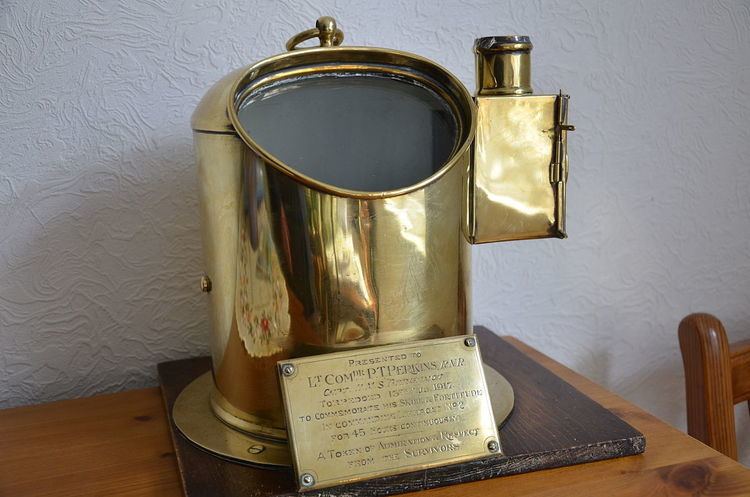Name HMS Bergamot Commissioned 14 July 1917 Construction started 1 January 1917 Tonnage 1.597 million kg | Laid down 1 January 1917 Launched 5 May 1917 | |
 | ||
Displacement 1,290 long tons (1,311 t) | ||
HMS Bergamot was an Anchusa-class sloop of the Royal Navy, which had a short career during World War I. Built by Armstrong Whitworth, the ship was laid down on 1 January 1917, launched on 5 May, and commissioned on 14 July.
Four weeks later, on 13 August 1917, under the command of Lieut-Commander Percy T. Perkins, she was sunk in the Atlantic 70 nautical miles (130 km) north-west of the harbour of Killybegs by the German submarine U-84, commanded by Walter Rohr.
His war diary describes how he sighted a lone merchant ship, with no defensive armament (an unusual sight by 1917). HMS Bergamot evidently sighted the U-boat's periscope, as she began to zig-zag at high speed. The U-84 fired one torpedo — which hit on the port side — and HMS Bergamot broke in half and sank in 4 minutes. Surfacing, the U-84 sighted an unusually large number of crew (70) and pieces of wood floating. The U-boat's log identifies the possibility of the Bergamot being a "trap ship". One of the indicators being the narrow beam in relation to the length of the ship, a sure sign of a warship.
The torpedo struck her on the port side, entering the auxiliary engine room and destroying the dynamo and the bulkhead separating the auxiliary engine room from the main engine room. All the lights went out. HMS Bergamot launched a "panic party" in lifeboat no.1, containing 31 men, but the ship lurched to port, both the bow and stern rising out of the water, and she sank too quickly for the ruse to be successful.
U-84 approached Lifeboat no. 2 and asked where the captain was. They were told, "In the other boat, Sir" although actually he was on a small raft being towed by no.2 at the time. U-84 had both her deck guns trained on the lifeboat, but they believed the story and headed for lifeboat no. 1, now about 2 miles away. There, they went close alongside and hauled the ship's steward aboard, probably because he was the only one with a collar and tie on, and looked like an officer. Luckily, he stuck to the cover story, although questioned severely by Rohr as to "where bound, what cargo?" and was told to go back to his lifeboat, after having been given a glass of port wine and a cigarette, and after also transferring a wounded man that the submarine had picked up to the boat. With a cheery, "See you after the war!" the submarine disappeared into the night mists.
At the moment of the explosion, the Bergamot's first officer, Lieutenant Frederick W. Siddall, and her probationer surgeon, Robert S.Smith were both in her wardroom. The explosion jammed both of the watertight doors leading into this compartment, and Siddall was rendered unconscious. Smith piled the wrecked wardroom furniture up in order to reach the skylight in the roof, and then dragged the unconscious Siddall up and out of the compartment. Having reached the main deck, Smith worked on both Siddall and a wounded Petty Officer, who was lying on the deck with a broken leg and arm. By this time the ship was clearly sinking so Smith inflated his casualties life vests and lowered them both into the water.
As HMS Bergamot sank one of her depth charges exploded, badly wounding Siddall and again rendering him unconscious. Smith towed both his casualties to lifeboat no.2, which had left the sinking ship, containing 47 survivors, and then worked on Siddall for 25 minutes, administering artificial respiration, until he again recovered consciousness. Smith then treated the other injured survivors in no.2 over the 48 hours that the lifeboats were adrift until they were picked up. For these life saving actions, Surgeon Robert Sydney Steele Cathcart Smith was awarded the Albert Medal.
The lifeboats became separated through the first night. Lifeboat no.2 set course for Loch Swilly, about 100 miles away, They sailed and rowed for three days before being picked up by the Admiralty trawler Lord Lister. Lifeboat no.1 reached the rocky shores of County Donegal where they were taken ashore by the coastguard.
For the unfortunate Smith and Siddall, this was the second time they'd been blown up in 6 weeks. They'd both been members of the crew on HMS Salvia when that ship had been sunk.
An interesting historical note is that the week before, Bergamot had experimented with towing a submerged submarine — E48 — thus resurrecting a 1915 method of trapping submarines.
